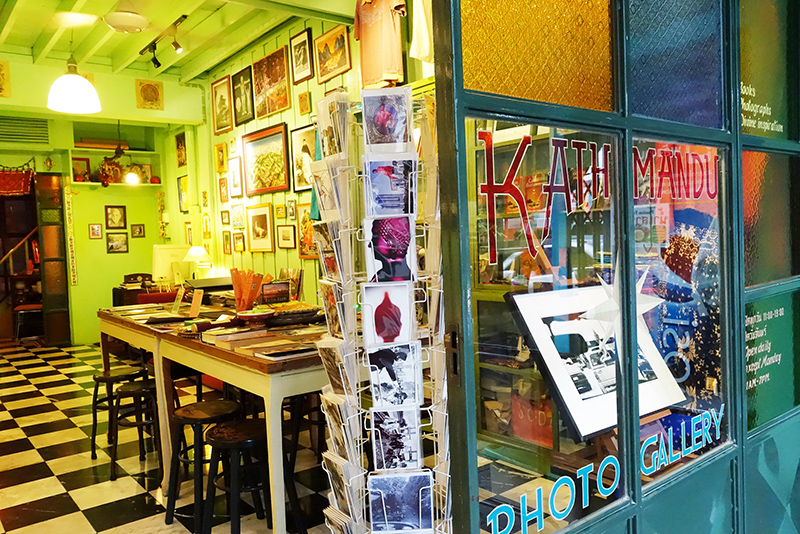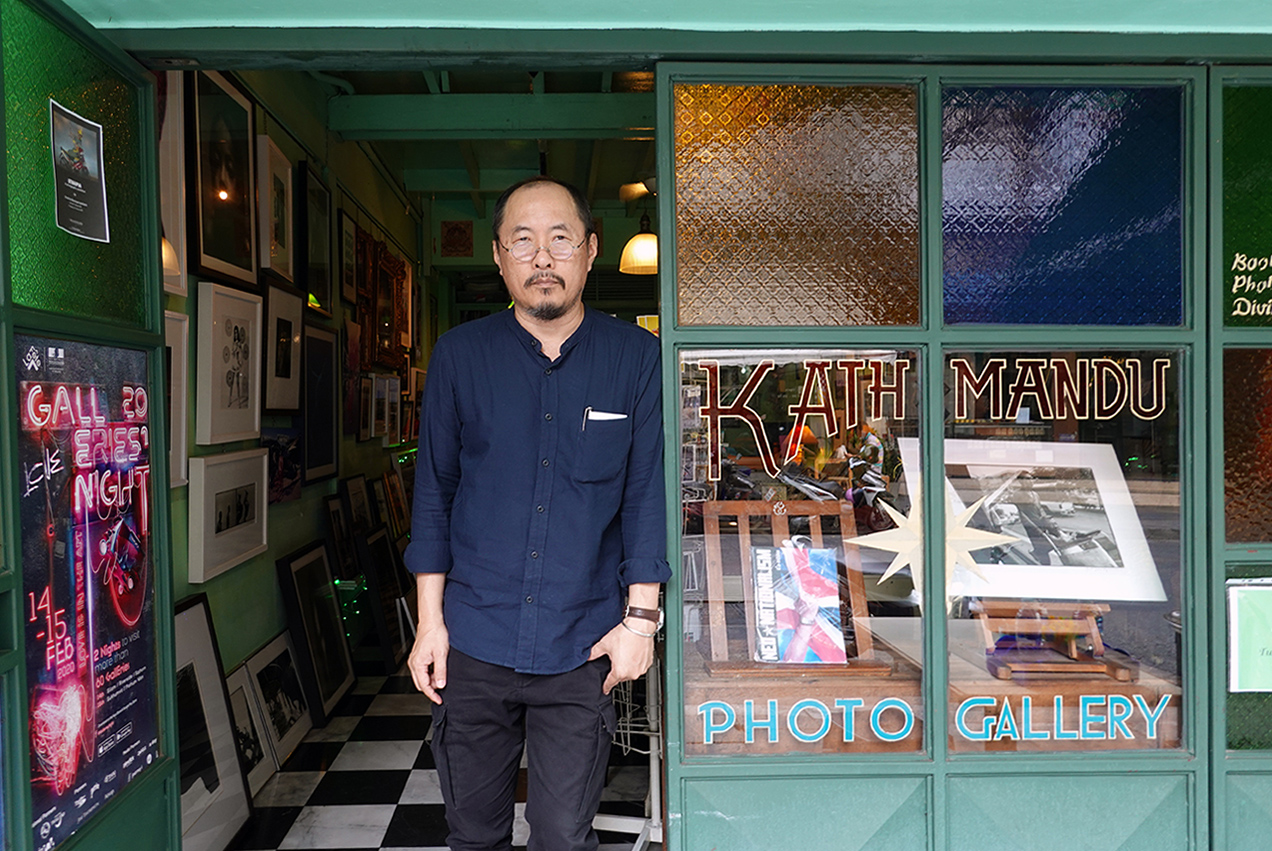Artist and curator of the Kathmandu Photo Gallery, Manit Sriwanichpoom, is the creator of the funny, bewitching and provocative Pink Man.
It’s funny but I have found myself taking photos less and less compared to five or six years back. I hardly pick up my camera. Maybe because digital technology has democratised the world. Everyone is a photographer. Social media is blitzed by photos. So my interest is shifting to existing photographs especially from the past.
Manit Sriwanichpoom

Let’s start at the beginning. What led to your journey in art?
In 1980 at the university I was lucky to have the photo artist Pramuel Burootsaphat as my art professor. He had just graduated from the US. His photography looked like painting with a lot of darkroom technique. It inspired me and opened my mind to the possibilities and potential of photography as a medium of artistic expression. In the meantime, my interest in art has been wide-ranging. Although I studied visual art, I involved myself in literature, drama and film. I believe we can learn from and be inspired by different disciplines. We shouldn’t limit ourselves to just one artistic area. The experience I got has freed me from any rule or norm of artistic practice.
How do you describe yourself in the context of challenging people’s perspectives via your work?
I’m an idealistic practitioner. I dream and make my dream come true. I can’t just keep complaining and criticising the world and let other people fix it.

Kathmandu Photo Gallery – exhibition space, 2nd Floor.
What does your role at Kathmandu Photo Gallery involve? How does a multi-hyphenate like you balance the contradicting elements of your work?
I did not really seek to take on the mantle of director and curator at the Kathmandu Photo Gallery. That also includes having the gallery space. But because there was no such space back then, I had to do it when the opportunity came along. Everything had to start from zero.
I have to be able to look at things from different perspectives. I have to understand the demands and expectations of artists, collectors and the audience. It’s not an easy thing to do.
Also, having a space is an important strategy to fight for what you believe in. It’s like religious priests of the past who needed to build churches to propagate their god. I didn’t open Kathmandu Photo Gallery just for selling my artwork. I needed a space from where I could promote creative ideas through photography and challenge the European and American-centric overview of the history of photography.

KMD First Floor. Manit Sriwanichpoom.
Tell us about your curatorial philosophy. How does it all come together?
I start everything with good art. The artwork must have something unique or stand out from the others, either content-wise, perspective-wise, aesthetically or as an idea. After that I have to think how to present it to the public through media and exhibition design. I also have to figure out when is a good time and where will the funding come from. When you have good art in your hand, half the job is already done.
Let’s talk about your long-term vision. Would it be safe to say that Kathmandu Photo Gallery is the first step towards manifesting this vision?
Yes. Since I have my own space, I’m able to explore and experiment my ideas to push the art scene forward. I can show some sensitive issues such as subjects relating to sexuality and religion through the photographic medium.
Let’s get imaginative. What is there a crying need for? What kind of a service or product would elevate the art industry?
Since opening Kathmandu Photo Gallery, I have been involved in organising the Photo Bangkok festival since 2015. It’s a triennial and the third edition is in 2021. I realise that Bangkok needs a photo fair to create a market for photo collecting in the country. We have plenty of art producers but no market for photowork. We have to develop a complete eco system for photography. This means we also need a photo museum as well.

Kathmandu Photo Gallery. Manit Sriwanichpoom.
Which shows, performances and experiences have shaped your own creative process? Who are your maestros? Whose journey would you want to read about?
I like Renaissance painters, especially Caravaggio, Artemisia Gentileschi, and then Goya and Manet. These artists had amazing life journeys. Their work reflected their time and the context they lived through.
Tell us about your own personal evolution, in relation to the work you do. What have you observed in the changing cultural landscape over time?
It’s funny but I have found myself taking photos less and less compared to five or six years back. I hardly pick up my camera. Maybe because digital technology has democratised the world. Everyone is a photographer. Social media is blitzed by photos. So my interest is shifting to existing photographs especially from the past. The continuing success of my project Rediscovering Thai Masters of Photography, which was shown at the Bangkok University in 2015, NUS Singapore in 2018 and Ilham Gallery, Kuala Lumpur, in 2019, gives me the momentum to keep the project going by doing more research about photography of the past.

In which ways do you think that photography can be an effective tool for activism? For instance, the Pink Man series.
Photography is one medium that people are familiar with and find easy to understand. People have a tendency to believe what they see in photographs, that is why newspapers are still using photographs for their reports. If a news photograph could move public opinion and sentiment, so why not use it for activism?
In one of your interviews I read that your first advice to young artists is to be honest, in your opinion what does honesty mean in the artistic field?
I have studied Marina Garcés’s essay Honesty with the real and I strongly believe that there can be an interesting connection to it! Artists must react to their thoughts and feelings honestly to themselves first. Especially when you’re dealing with public issues you have to be true to yourself. Otherwise nobody will believe in what you say or do. Honesty is your protection when you’re under attack by your enemy.

Manit Sriwanichpoom in front of Kathmandu Photo Gallery. 2020.
What are you working on now? What should we look forward to?
I have two projects: one is the Pink Man book. It’s a collection of my Pink Man series that I have produced for over 20 years. And another one is curating an old photo exhibition by the Prince of Kamphaengphet, Purachatra Jayakara, who lived between 1881 and 1936, for the next Photo Bangkok in 2021. He was the pioneering director of State Railways. The stereoscopic photos from his extensive travels have never been shown or seen by the public before. This is going to be the first time and audiences will experience early 3D imagery of a century ago. Manit Sriwanichpoom.












Add Comment